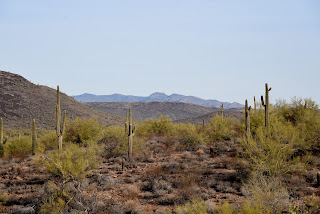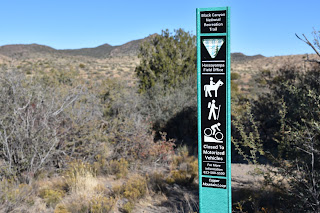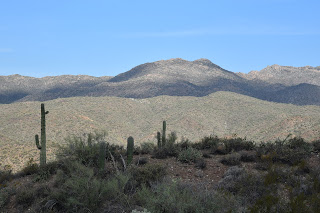BLACK CANYON NATIONAL RECREATION TRAIL: EMERY HENDERSON SEGMENT
 |
| New River Mountains seen from Black Canyon Trail |
The Emery Henderson trailhead on New River Road is one of the most convenient points of access to the Black Canyon National Recreation Trail from the Phoenix area.
 |
| Looking north on the Black Canyon Trail |
The 100+-mile historic route runs north from Carefree Highway to the Verde Valley roughly parallelling Interstate 17 along its rugged course.
 |
| Saguaros are a key attraction on the hike |
The second leg in the trail, the Emery Henderson segment
straddles desert flats and floodplains between the freeway and the Agua Fria River that spills into Lake Pleasant in the northwest Valley.
 |
| The Emery Henderson trailhead |
Its 4-mile length wanders through the last vestiges of neon and industry before ducking into mountainous backcountry, but not before delivering one of the best trips through saguaro cactus country anywhere.
 |
| Some old trail posts are still standing along the route |
But, before it gets to the good stuff, hikers must trudge through a half mile of bland terrain, cross the North El Paso Gasline Road and listen to firearms noise from a nearby shooting range. Sucking up these minor annoyances pays off quickly, though.
 |
| An impressive specimen in the Agua Fria floodplain |
Following a rocky two-track the trail soon departs the “Sahara of the Suburbs” and tucks into shadeless plains of cholla and creosote surrounded by mountain ranges. The distinctive mound of 2,980-foot Gavilan Peak dominates the eastern horizon while band of mesas including 2,857-foor Wild Burro Mesa bolster the western skyline. Where the route begins an easy descent into the floodplains of the Agua Fria River, desert flora, led by majestic saguaros, clutters runoff channels and crumbling foothills.
 |
| New River Mountains to the northeast |
 |
| Dead saguaros are havens for wildlife |
Gigantic saguaros sprout from an earthen stew of white quartz chunks, basalt blobs, assorted metamorphic stones and sediments. This complex show of geology belies the area’s rich mining history.
But it’s the saguaros that are the segment's signature feature. They huddle in masses around gullies, stand as lone sentinels over pebbly flats and show up as contorted,zoomorphic forms begging to be named. Even the dead ones live on as havens for wildlife and subjects for detail-driven photographers. A smattering of ironwoods and Palo Verde trees sink roots deep into the major drainages that the trail crosses, providing what little shade the trail has to offer.
 |
| Desert icons on the Black Canyon Trail |
 |
| Name that saguaro |
The segment ends where the 3.2-mile Boy Scout Loop takes off. Hikers may turn back here for a moderate 7.6-mile trek or loop around for a long 10-miler. Either way, Arizona’s most iconic cacti are constant trailside companions.
LENGTH:
7.6 miles roundtrip to the loop and back
10.4 miles roundtrip with loop
RATING: moderate
ELEVATION: 1,858 1,989
1,850-1,974 feet to the loop
1,850- 2,315 feet with loop
GETTING THERE:
Emery Henderson Trailhead:
From Phoenix, take I-17 north to exit 232 (New River Road). Turn left and follow New River Road for 3 miles and look for the Emery Henderson Trailhead turn off on the right. The roads are paved all the way to the trailhead where there are restrooms (out of order at this writing), hitching posts, covered picnic areas and plenty of parking and an occasional site host.
INFO & MAPS:















































